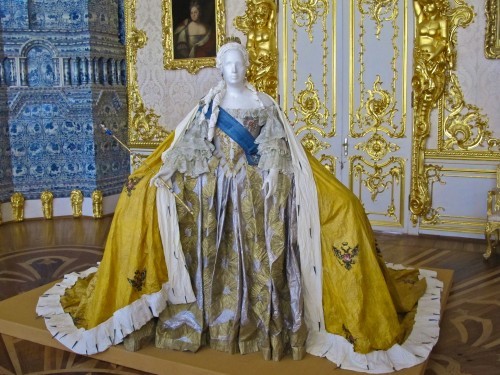St. Petersburg was the next stop on our beyond-amazing adventure. Geesh, did we ever had a great time. Mind and eye candy were everywhere we looked. I decided to break up the St. Petersburg leg of our trip up into 2 posts because there are soooooo many photos and tons of information….& I don’t want to overload you, dear readers (Silver Lining)!
We took the high-speed train called Sapsan to St. Petersburg. On our way to our hotel (the Rocco Forte Astoria), I was overwhelmed by how beautiful the city is. I mean, beautiful! En route we passed the famous bronze horseman statute of Peter the Great, the Strelka and the grand Nevsky Prospect, St. Petersburg’s main avenue.
On our first day in St. Petersburg, we drove to the town of Pushkin (southeast of St. Petersburg) to see Catherine Palace. The residence originated in 1717, when Catherine I of Russia engaged the German architect Johann-Friedrich Braunstein to construct a summer palace for her pleasure. Our hilarious and fabulous guide referred to Catherine I as “The Laundress” because, well, that is what she was before she snatched, I mean married, Peter the Great. Apparently Peter the Great was a rather simple man (now let me in on a little secret: everything is relative in Russia) and did not like the palace one bit.


Moving on to the next generation…Empress Elizabeth found her mother’s residence outdated and incommodious (remember what I said about everything being relevant?!?) and in May 1752 asked her court architect Bartolomeo Rastrelli to demolish the old structure and replace it with a much grander edifice in a flamboyant Rococo style. Construction lasted for four years and on July 30th 1756, the architect presented the brand-new palace to the Empress, her dazed courtiers, and flabbergasted foreign ambassador.

Gold…Gold…Gold…and Gold

One of Catherine the Great’s little frocks.

The Ballroom
Although the palace is popularly associated with Catherine the Great, she actually regarded its “whipped cream” (uh huh, that’s how she referred to it) architecture as old-fashioned. When she ascended the throne, a number of statues in the park were being covered with gold, in accordance with the last wish of Empress Elizabeth, yet the new monarch had all the works suspended upon being informed about the expense. In her memoirs she censured the reckless extravagance of her predecessor.

When the German forces retreated after the siege of Leningrad, they had the residence intentionally destroyed, leaving only the hollow shell of the palace behind. Can you even imagine? Geez-Louise. Prior to World War II, the Russian archivists managed to document a fair amount of the contents, which proved of great importance in reconstructing the palace (Silver Lining, right?). Although the largest part of the reconstruction was completed in time for the Tercentenary of St Petersburg in 2003, much work is still required to restore the palace to its former glory.

On our way back to St. Petersburg, we stopped at the famous Yusupov Palace on a quiet stretch of the Moika River. The Palace was once the residence of the wealthy and respected Yusupov family and saw one of the most dramatic episodes in Russia’s history – the murder of Grigory Rasputin. Our guide told the story in a most colorful way!
In 1916 a group of the city’s noble elite, including one of the Grand Dukes and led by the prominent anglophile Prince Felix Yusupov, conspired to kill the one man who they felt threatened the stability of an already war-torn Russian Empire. Grigory Rasputin, a peasant and self-proclaimed holy man, had gradually won favor with the Tsar’s family through his alleged supernatural powers. His control over the decisions of the family and the Russian ruler himself, put him in a potentially manipulative position and posed a very real threat to their power. Consequently, Rasputin was murdered at the Yusupov Palace on the night of December 16th, 1916, and his death proved to be an almost greater mystery than his life had been. We saw the room where the plot was formulated and I must say that it was super-creepy.
The palace, however? Wowsy-Bowsy. In addition to the HOTY loving the carriage room in Moscow, his second favorite place on the the trip was the famous theatre in Yusupov Palace. My photos don’t do it justice…suffice it to say that it is beyond belief. This palace is only opened by special request and not open to the public.
Another magnificent stop was The Church of Our Savior on Spilled Blood. This beautiful Russian-style church was built on the spot where Emperor Alexander II was assassinated in March 1881. Alexander II was a beloved ruler in Russia. After assuming power in 1855, Alexander II initiated a number of reforms. In 1861 he freed the Russian serfs from their ties to their masters and undertook a rigorous program of military, judicial and urban reforms, never before attempted in Russia. However, during the second half of his reign Alexander II grew wary of the dangers of his system of reforms, having only barely survived a series of attempts on his life, including an explosion in the Winter Palace and the derailment of a train. Alexander II was finally assassinated in 1881 by a group of revolutionaries, who threw a bomb at his royal carriage. The palace is breathtaking. Absolutely magnificent.
More tomorrow…





Great pictures and interesting information. What a great experience! Were you able to use your French language skills in Paris?!
Kim
Thanks, Kim!
J'ai utilisé mon français autant que je le pouvais!
Amazing pictures I would love to go there. thanks for sharing.
Thanks so much! Hope you do indeed get to travel there one day!
Hollye